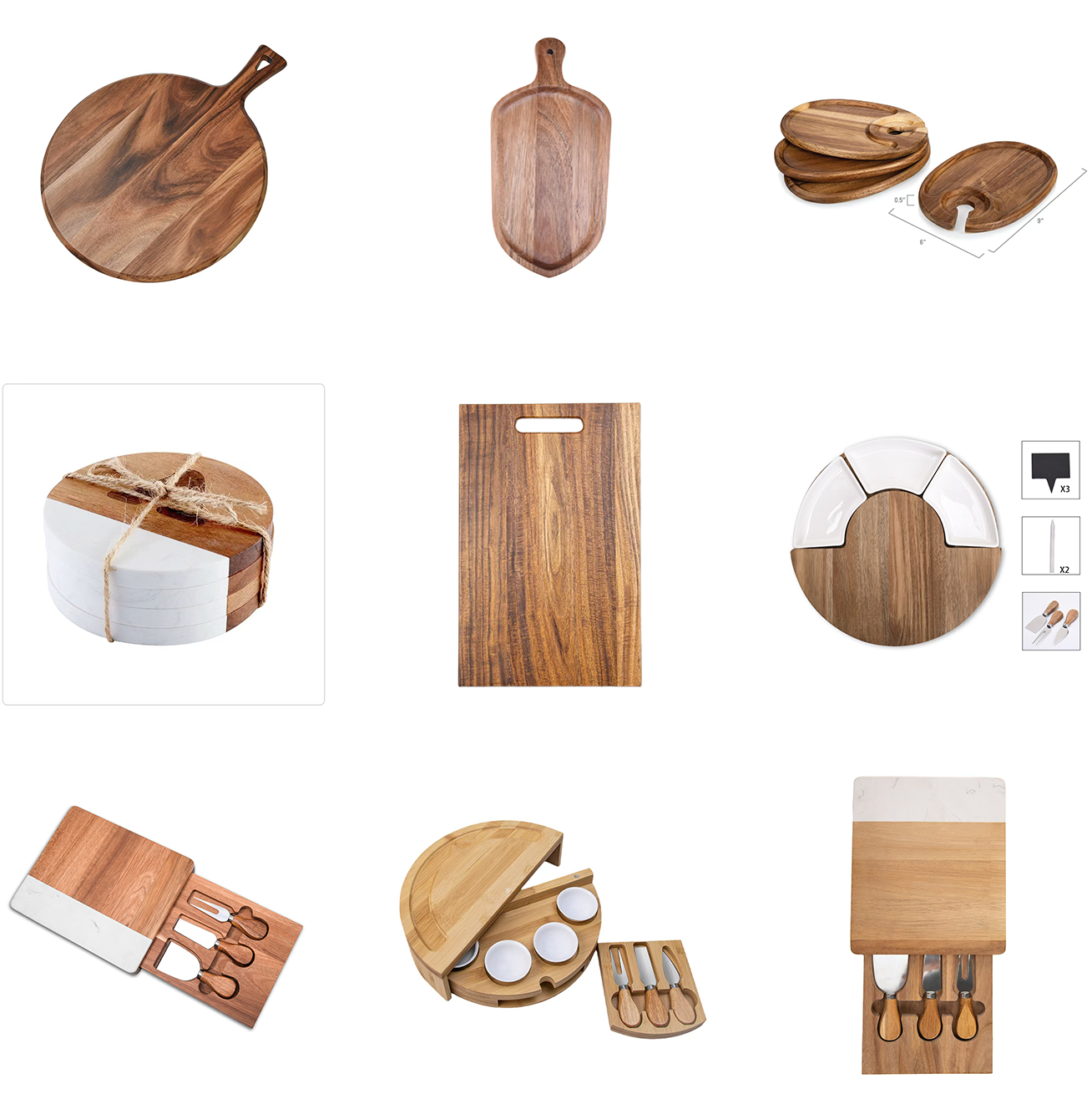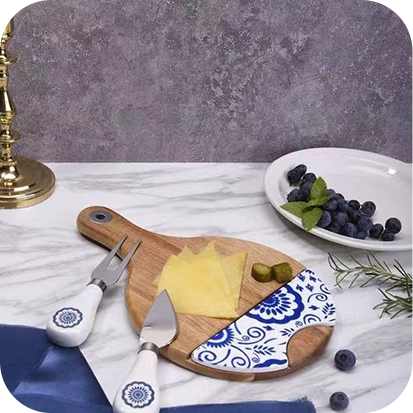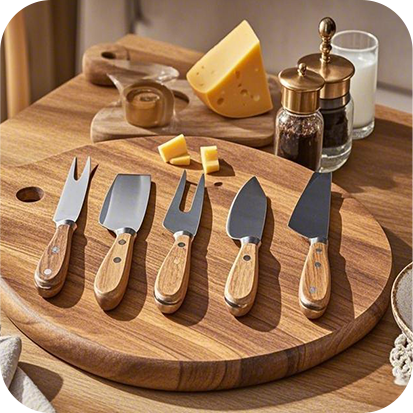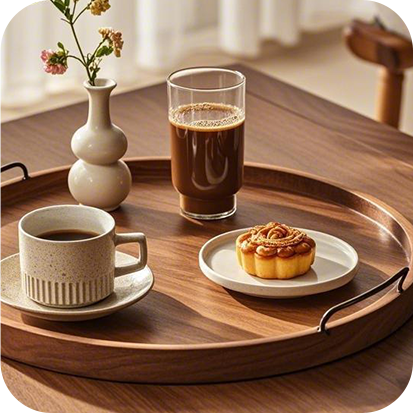Why Culinary Schools Trust Acacia for Safe, Sustainable Food Prep
Why Culinary Schools Trust Acacia for Safe, Sustainable Food Prep
In the demanding environment of culinary schools, where aspiring chefs learn both fundamental techniques and modern best practices, the choice of kitchen equipment is more than a matter of tradition—it’s about safety, sustainability, and performance. Among all the options, Acacia wood boards have emerged as the preferred choice over composite and plastic alternatives. But what drives this preference, and why do educators and professionals worldwide now trust Acacia wood boards for training the next generation of chefs?
The Growing Focus on Food Safety in Culinary Education
Food safety is not just a module in the curriculum—it's a mindset deeply embedded in every aspect of culinary training. Modern schools understand that safe food preparation begins with the right cutting surface. Acacia wood, a dense and naturally antibacterial hardwood, offers an ideal foundation. The Sustainable food-safe adjustable Acacia wood Vegetable cutting board is a prime example of how Acacia combines environmental responsibility with food-safe design. Unlike composite boards, which may contain chemical binders or resins that can leach into food over time, Acacia’s food-safe finishes and natural antibacterial properties give both students and instructors peace of mind.
The Limits of Composite Boards: Durability, Hygiene, and Health
While composite boards have gained popularity due to their affordability and lightweight construction, they often fall short in the rigorous environment of a culinary school. Composite surfaces are prone to deep cuts that harbor bacteria, and over time, they can warp or degrade with repeated washing. Many composite boards also lack the adjustability and sustainability features found in top-tier Acacia boards. Schools aiming to teach best practices quickly realize the long-term risks and maintenance costs associated with composites.
Sustainable Choices: Teaching Environmental Responsibility
Today’s culinary institutions don’t just teach recipes—they instill values. Sustainability is at the core of modern kitchen education, and students are encouraged to understand the environmental impact of their tools. Acacia, as a fast-growing, renewable resource, offers a compelling story. The Two-way use Biodegradable Timeless Acacia wood carving board demonstrates how sustainability can be integrated into daily practice. This board’s biodegradable design supports green kitchen operations, allowing students to practice environmental stewardship as part of their training.
Performance: Precision, Adjustability, and Real-World Use
Culinary students practice thousands of knife cuts, from chiffonade to julienne. They need boards that provide the right level of “give” to protect knife edges and reduce wrist strain. Acacia’s dense, fine grain absorbs impact without blunting blades—a critical factor when mastering delicate knife work. Adjustable options, such as the Sustainable food-safe adjustable Acacia wood Vegetable cutting board, let students customize their setup for different tasks, encouraging good habits they’ll carry into professional kitchens.
Hygiene: Natural Cleanliness Without Compromise
The battle against cross-contamination starts with easy-to-clean equipment. Acacia’s natural antibacterial qualities make it easier to maintain strict hygiene standards, even during busy class sessions. The Dual-sided Clean Retro Acacia wood carving board allows students to separate tasks by using different sides for meat, vegetables, or pastry, reinforcing classroom lessons about food safety and workflow organization.
Customization and Versatility for Every Lesson
Culinary school kitchens are used for everything from knife skills to advanced pastry and butchery classes. The Food-safe stainless steel customizable Acacia wood Serving board bridges tradition and innovation, offering a durable wood surface with the added benefit of stainless steel features. This board adapts to a wide variety of uses, whether for classroom demonstration, buffet service, or plated presentation—illustrating how Acacia supports both classic and modern training methods.
Health and Well-Being: Why “Natural” Matters
Increasingly, chefs are aware of the health impacts of synthetic materials, especially those with unknown additives or microplastics. Acacia’s authenticity and chemical-free preparation reduce health risks for both instructors and students. The Both-side usable Healthy Authentic Premium wood cutting board reinforces this commitment to well-being—providing a safe, natural surface that is gentle on knives and healthy for hands-on learning.
Longevity, Cost, and Institutional Investment
While composite boards may seem cost-effective initially, their lifespan is generally shorter due to wear, warping, and the need for frequent replacement. Acacia boards, with their robust build and resistance to deformation, offer superior return on investment. Culinary schools, often working within tight budgets, appreciate the long-term value of a durable Acacia board that supports year after year of intensive training.
The Broader Impact: Preparing Students for the Professional World
When culinary students are trained on Acacia boards, they develop habits and expectations that carry over into the restaurant industry. Chefs accustomed to sustainable, food-safe, and reliable equipment become advocates for those same standards in their professional kitchens. By choosing Acacia, culinary schools are shaping not just individual careers, but the broader culture of food service—where safety, sustainability, and performance are non-negotiable.
Educator Testimonials: Real Experiences with Acacia Boards
Instructors at leading culinary academies praise Acacia boards for their “consistent performance,” “easy cleaning,” and “positive student feedback.” Many highlight how dual-sided, adjustable, and customizable Acacia boards accommodate various lesson plans, giving students the flexibility to learn with confidence. Feedback from alumni also suggests that familiarity with Acacia products gives graduates an edge in professional kitchens, where food safety and efficiency are prized.
Summary: Why Acacia Leads the Way
Culinary education is more than skill-building; it’s about setting standards for a safer, greener, and more professional food industry. Acacia boards—thanks to their food safety, sustainability, versatility, and durability—have become the gold standard for culinary schools worldwide. As kitchen technology and education evolve, the enduring benefits of Acacia ensure it will remain at the heart of chef training for years to come.
Ready to equip your school or kitchen with the best in wood kitchenware?
Partner with one of the best Chinese OEM manufacturers—with 16 years’ experience producing wood kitchenware!
Contact us at info@justwoodencuttingboard.com or WhatsApp: +86 183 1248 3616 to learn more about sustainable, food-safe Acacia boards for culinary education or professional use.
READ MORE:


Yangjiang Cuthaven Kitchenware Co.,Ltd
Yangjiang Cuthaven Kitchenware Co.,Ltd.
specializes in the production and export of high-quality metal and wooden kitchenware. With over 16 years of experience in the industry, we have established ourselves as a trusted partner for businesses worldwide.


















